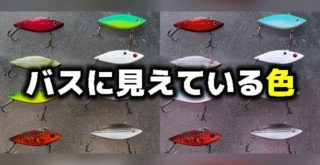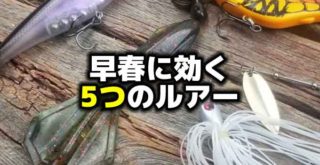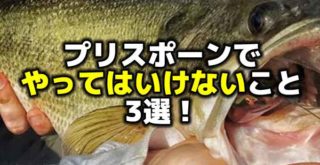知るとガッカリする?バスの目の見え方、色の見え方

Photo by midwestoutdoors.com
こんにちは!店長の小山です!
本日は海外サイトより、”HOW A BASS SEES COLOR”という記事を引用してご紹介いたします。
引用先:midwestoutdoors.com”HOW A BASS SEES COLOR”by RON KRUGER , SEP 1, 2017(海外サイトです)
このブログを読んでいただいている皆さんにとって、ブラックバスの生態というのは非常に大きな興味があるものだと思います。
私にとってもまさにそうで、バス釣りが好きということは、バスが好きで、バスのことをもっと知りたいと思います。
バスの生態というのは、バスが普段から何を食べて、どこにいて、というようなバスの生活についてのことになりますが、もうひとつ、バスの機能、器官といった身体能力ついても大きな興味がありますよね。
このブログでもこれまでにバスの生態や身体能力についていくつかとりあげてきましたが、今回もそのシリーズで、バスの目線での見え方、色の見え方についてのお話です。
自分を例にあげればこれは、思春期に恋した時の感情とまったく一致します(笑)
好きになったあの子は、いつもどんな生活をしてて、どんなものが好きなんだろう、あの子の目から見て自分はどんな風に見えているんだろう…。そんな感じで悶々とした日々を過ごしていました。
年を取った今、その感情はそのまま、バスに向けられています。
好きになったあの子のために、手を変え品を変えプレゼンテーションをします。気に入られようと必死です。お金もかかります。しかし食いついてくれるのはほんのわずかのことのみ…。やっぱりもっと相手のことを知らなければだめだと、こういうわけです。
皆さんはどうでしょうか。皆さんも私と同じだと嬉しいのですが…。
この記事は、アメリカ中西部の総合アウトドアメディア「Mid West Outdoors」の記者、ロン・クルーガー氏によるもので、自身の経験や科学的視点に基づいてバスの目の見え方や色の見え方について書かれています。
いくつか扱ってきたバスの色覚についての記事とはまた違った内容ですので、とても興味深いものです。ぜひ読んでみて下さい。
バスは色をどう見ているか
Longtime guide Malcolm Lane and I both believe that color is our least important consideration when choosing bass lures. This may seem controversial, but we don’t just base it on personal observations. Some solid science has greatly influenced our opinions.
In the first place, it probably is a mistake to judge the vision of the bass on our own because bass see everything a bit differently than us, and not just because they live in different environment. It’s because their eyes function much differently than ours.
For one, their eyes are placed on the sides of their heads, affording them “monocular vision,” which means they can see well on both sides of their heads simultaneously. Each eye has the ability to see over a 180-degree range, so their only “blind spot” is a narrow area directly behind them where their body obstructs their vision. We have “binocular vision,” which restricts our field of view to the front but allows us great depth-of-field perception.
Fish are nearsighted, so unless a lure makes noise, it needs to be cast closely to a bass to be detected. Fish also have limited binocular vision, similar to ours, and in a narrow band directly in front of them. Their binocular vision, however, is really just an overlapping of their monocular vision. So although they can see things at a little greater distance, the objects are blurred and depth perception is impaired, sort of like the way we see if we cross our eyes slightly. This is why you often see a bass make a little swoop to the side at the last second before they strike a lure they’ve been following from behind. This little sidestep at the last second allows them to see the bait the most clearly the instant before they take it. Short strikes or complete misses could mean they saw something distasteful upon closer inspection. Under their clearest vision and during a last-second swoop, a bass sometimes changes its mind like a batter checking his swing on a pitch he decides is not good to hit.
was why a bass hit this or that model, when in fact most of the bass we catch are fooled during times when they can’t actually distinguish the difference between colors well. If what you’re using is catching them well during the middle of the day, color might be the key. Early and late in the day, however, they may be hitting that “latest and greatest” model not because of the fancy finish that caught your eye and emptied your pocket, but are doing so in spite of it, making presentation the important factor.
長年のバスフィッシングガイドであるマルコム・レーン氏と私は、バスのルアーを選ぶ際には色が最も重要ではないと考えています。これは議論の余地があると思われるかもしれませんが、私たちはそれを個人的な観察だけに基づいて言っているのではありません。いくつかの確かな科学が、私たちの意見に大きく影響しています。
まず、バスは私たちとは異なる環境に住んでいるという理由から見え方が少し違っているということだけでなく、私たち人間の見え方をバスに当てはめて判断するのが間違いでしょう。彼らの目は私たちとはまったく異なって機能するからです。
理由としては、彼らの目は頭の両側を同時に見ることができる “単眼の視覚"があり、そしてそれは彼らが頭の両側を良く見ることができるということを意味します。それぞれの眼で180度の範囲を見ることができますが、唯一の「盲点」は、自分の身体が視界を妨げる自分のすぐ後ろの狭い領域です。私たちの視界は正面だけに制限されていますが、奥行き(立体)の認識を可能にする「双眼視」を持っています。
魚は近視のため、ルアーがノイズを発する場合を除き、バスに気付かせるにはより近くにキャストする必要があります。魚にはまた、我々のような双眼視力が正面だけの限られた狭い範囲にあります。しかし、彼らの双眼視力は単眼視力が重複しているだけです。そのため彼らは、少し遠くまでなら物を見ることができますが、その物体はぼやけて、奥行きの知覚は損なわれています。私たちの目のすぐ前を何かが横ぎった時と同じような感じです。これは、ルアーを後ろから追いかけてきてバイトする前の数秒間、バスがしっかりと観察しているのをしばしば見る理由です。最後の数秒でバイトするのをやめるということは、その前に彼らがルアーをかなり鮮明に見ることが可能ということです。ショートバイトまたは完全なミスバイトは、その見極めの段階で何かが気に入らなかったということを意味する可能性があります。彼らの最も鮮明な視界の下で、そしてバイトする最後の数秒間の間に心変わりするのは、ピッチャーが投げた球に対してバッターがヒットにできないと思ってスイングを途中で止めるのと同じであるのです。
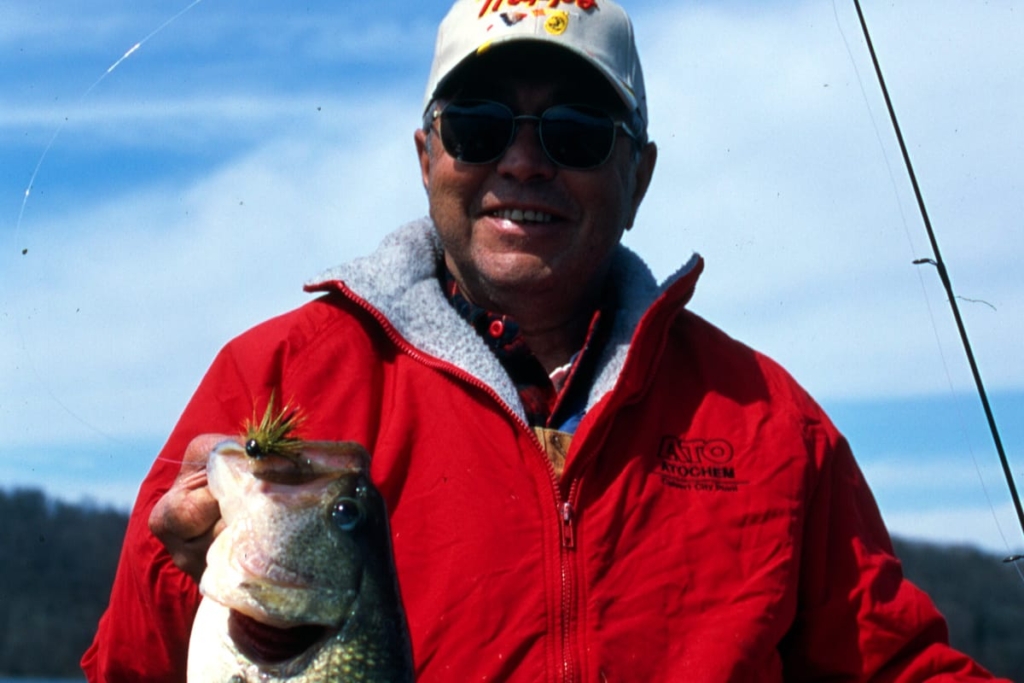
Photo by midwestoutdoors.com
Scientists believe that bass receive about five times more light through their eyes than humans. This, of course, gives them better vision in deep, dark areas, but it doesn’t mean they can see five times better than a human. Simply put, they are five times more sensitive to light. They have a fixed lens, and their cornea is of uniform thickness. They don’t have eyelids or pupils to dilate and compensate, so they make up for this by seeking shade or moving deeper. The bass need this extra sensitivity because water absorbs light quickly. The deeper or more turbid the water, the less light there is to reflect off objects. Plus, when ripples break the surface, some of the light is refracted so the diffusion of light is rapid. Often, just a few feet or the shade of a fallen tree is enough.
The most confusing aspect of their sight is the fact they have two types of receptor cells in their retina. Their “cone” cells perceive color and are used mostly during the day; their “rod” cells see only in black and white and are used at night. These receptor cells reverse themselves every 24 hours, so bass are actually color blind about half the time. Consider that the next time you’re trying to pick out the perfect color.
Sometime before sunset, a bass’ internal senses trigger the advance of black and white vision in preparation for darkness. Completion of this process takes hours, so it’s believed they have a sort of “color fade” as the rod cells advance. Then, just before daylight, the cone cells begin to advance, causing a gradual recognition of colors. For most of the morning and for most of the evening, their ability to distinguish different hues of the color spectrum is limited. Ironically, that is usually when we do best with our lures of many colors.
We often think that the color of a lure was why a bass hit this or that model, when in fact most of the bass we catch are fooled during times when they can’t actually distinguish the difference between colors well. If what you’re using is catching them well during the middle of the day, color might be the key. Early and late in the day, however, they may be hitting that “latest and greatest” model not because of the fancy finish that caught your eye and emptied your pocket, but are doing so in spite of it, making presentation the important factor.
科学者たちは、バスは人間の約5倍の光を眼で受け取れると信じています。これはもちろん、ディープの暗いエリアでより良い視界を提供しますが、人間より5倍も優れた視力を持つことを意味するわけではありません。簡単に言えば、彼らは光に対して5倍の感度があるということです。彼らは固定されたレンズを持っており、その角膜は均一な厚さです。彼らは、まぶたや瞳孔を広げたりして調節することがないので、シェードを探したり、よりディープへ移動することでこれを補います。水は光を素早く吸収するので、バスはこの素晴らしい感度を必要とします。ディープや濁った水ほど、物体から反射する光が少なく(認識しずらく)なります。さらに、水面が波立つことで、光の屈折や拡散が急速になるため、わずか数フィートの木陰程度で充分になります。
彼らの視力について最も混乱しやすい面は、網膜に2種類のレセプター(受容)細胞(光を感知する細胞)があるという事実です。そのひとつ「コーン」細胞は色を知覚し、ほとんどが日中に使用されます。もうひとつの「ロッド」細胞は白黒でしか見られず、これは夜間に使用されます。これらのレセプター細胞は24時間ごとに逆転するので、実際にはバスは約半分の時間が色のわからない状態ということです。次回あなたが完璧なルアーの色を選ぶとき、このことを考えてみてください。
日没前になると、バスの内部感覚は暗闇に備えるために白黒の視界になっていきます。このプロセスの完了には数時間かかるので、ロッド細胞が進むにつれて一種の「色あせ」状態になると考えられています。その後、日中になる前に、コーン細胞が進み始め、色が徐々に認識されるようになります。朝および夕方の大部分において、色彩の異なる色を区別する能力は限られているのです。皮肉なことに、それは通常、私たちが多くの色のルアーを使って最善を尽くす「まづめ時」ということです。
私たちはよくルアーの色のことを、実際には色の違いをよく区別できていない時間帯に釣れたバスを指して、そのカラーやルアーにバイトしたんだと考えています。あなたが使用しているルアーで日中にバスを釣っているなら、色がキーになったのかもしれません。しかし、その日の早朝や夕方の場合は、財布を空っぽにしてまで買った最新のルアーが効いたのではなく、プレゼンテーションが重要な要素だったということなのです。
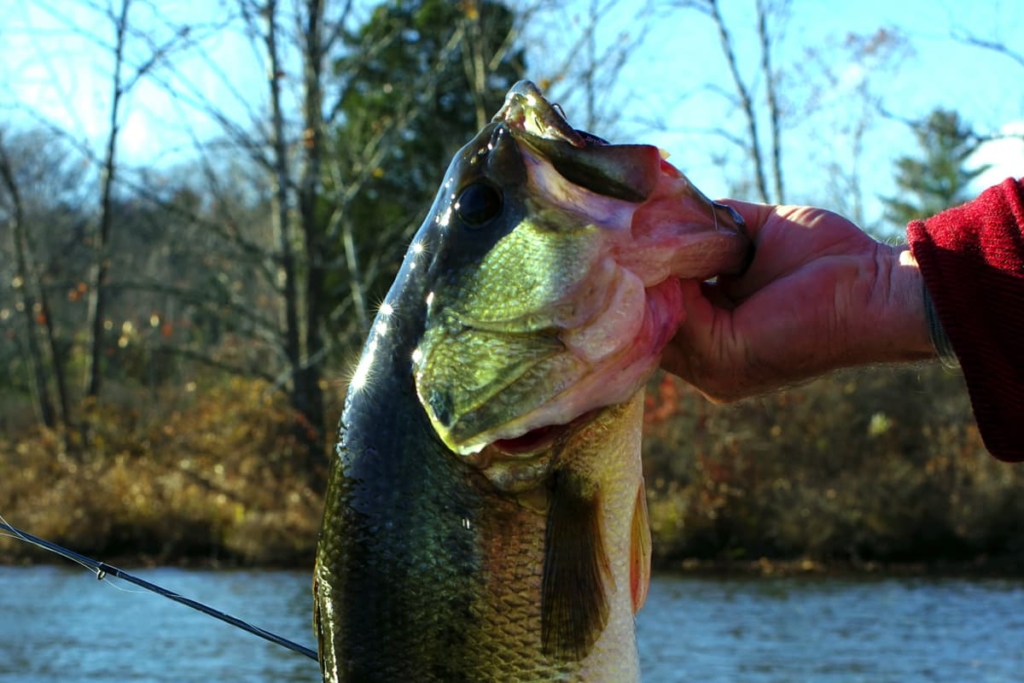
Photo by midwestoutdoors.com
いかがでしたか。
なんかちょっとつまんない感じー。なんて思いますよね(笑)
一生懸命考えたルアーのカラーなのに、朝まづめや夕まづめにはほとんど意味がなかっただなんて…。
いえ、まったく意味がないうことではないはずです。
ベイトフィッシュの色彩をそのまま模したものは、ベイトフィッシュが放つ色彩なわけで、カラフルに見えていない白黒視界のバスにも、その濃淡は認識出るはずで、色彩が同じということは濃淡も同じになるはずですから、バスにとってはそのベイトフィッシュと認識するはずです。
なので、まづめ時のカラー選択が無駄だったとは思いたくないのですが…。
代わりに、良いニュースとすれば、まづめ時はカラーよりもアプローチの方が大切ということがわかりましたので、カラーを気にせずキャストの手数勝負に持ち込めばいいんですね。カラーで迷うヒマがあったらキャストしよう、という感じでしょうか。
逆に日中は、よりカラーに対してシビアに考えたほうが良いようです。日中によく釣る人は、カラーが合ってる。カラー選択が上手。そう考えればいいんですね。そういう人の情報を信じましょう(笑)
ただし、今回の記事が必ずしも本当かどうかは、正直、分かっていません。信じるも信じないも自分次第ですが、一つの意見として知っていると、また新たな謎に挑戦できますし、自分なりに検証してみるのも楽しいのではないでしょうか。そういう風にお考えいただけると助かります。
しかしアメリカというのはバスの研究が盛んなことで、とてもうらやましいですよね。探してみればそんな記事がもっともっとあるのでしょう。
私ももっともっとバスについて知りたい身ですから、何かありましたらできるだけ共有したいなと思います。
友達が同じ女の子を好きになったと知った時、ちょっと嬉しいような気持ちになりますし、ライバルにもなりますけど、フェアに情報交換はする、そんな気持ちに似てますよね(ちがうかな
青春たとえ話がしつこくてすみません…
それでは、また。
毎度ありがとうございます!









